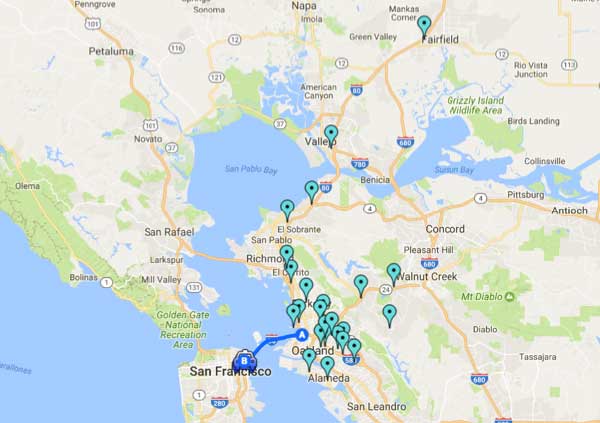While the Bay Area is known for its ride-hailing transportation startups, a low-tech casual carpool system has continued to thrive into its fourth decade. Amid discussions of near-term Transbay capacity relief measures, the disorganized and austere casual carpool system is primed for enhancement, provided that its egalitarian structure can remain intact.
Casual carpool began in the 1970s as a means of saving time and money on the Transbay commute; in recent years, it has also increasingly drawn passengers fed up with overcrowded BART trains. Each morning, casual carpool passengers from Alameda to Fairfield wait at one of 24 usually unmarked East Bay pickup locations for a free or cheap ride to Downtown San Francisco. Each pickup location has its own unique etiquette related to donations ($1 contribution are optional but sometimes suggested), radio station (NPR and KPFA are popular choices), and dialogue (the driver is expected to initiate), but the system as a whole is surprisingly seamless.
Data on casual carpooling is hard to come by. The most recent publicly available data from FY 2010-2011 counts about 1,700 passengers waiting at 12 of the 24 AM sites (about 10-20 percent of passengers carpool home during the PM commute). Today, it’s reasonable to estimate that casual carpool accounts for upwards of 5,000 person trips every morning (assuming total carpool passengers were double that of the count, adding approximately 500 drivers who were not counted, and accounting for some growth in Transbay commutes). That may not seem like a huge total compared to roughly 60,000 BART trips, but it’s not insignificant either – it about equals the total ridership of all AC Transit/WestCAT Transbay buses and WETA ferries combined. For a system without taxpayer funding, that level of productivity is extraordinary.
Nevertheless, casual carpool is successful in spite of a lack of support from the Metropolitan Transportation Commission (MTC) and the cities that it serves. When MTC began tolling carpools in 2010, carpooling as a whole decreased by 26 percent, but has seemingly somewhat recovered. Yet, barriers to participation in casual carpool remain significant for someone who isn’t “in the know.” Casual carpool locations often lack signage, waiting areas, and even passenger loading zones. Passenger supply and rider demand is often mismatched between nearby locations without an effective means of balancing resources. There is no official website: the first unofficial website to appear on a Google search hasn’t been updated in 18 months; the second unofficial website isn’t bad, but lacks functionality for trip planning.
As a part of the Bay Bridge Forward program, MTC is finally being more proactive in improving the casual carpool system’s efficiency, access to information, and the rider experience. While little is known about what exactly MTC intends to do beyond establishing new locations, one would imagine the top priority should be the creation of a functional website and official social media accounts (Facebook, Twitter, Nextdoor, etc.) to improve coordination with riders. Improvements to signage and waiting areas are also warranted, both to ensure safety and to create more of a station-like presence. A more challenging issue is how to better manage supply and demand between drivers and riders – a technological solution such as a modified version of Scoop may be helpful. Ultimately, a reevaluation of the Bay Bridge tolling structure may be warranted to encourage more carpooling.
While it’s fun to focus on necessary big ticket investments like a second tube, contraflow bus lane, or west span bike path, sometimes these conversations can lose sight of cheap improvements that can have a big impact. It’s time we put more resources toward casual carpool to build upon its success and bring in a new wave of passengers.


